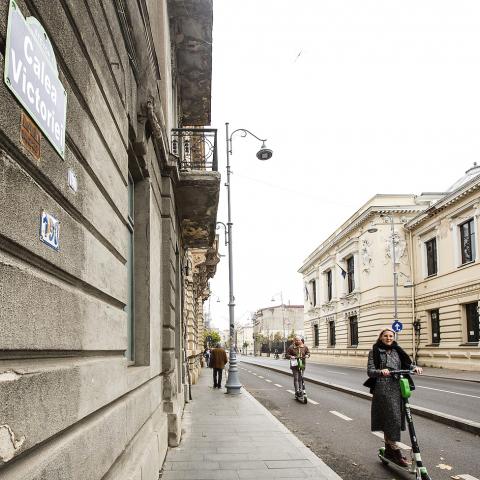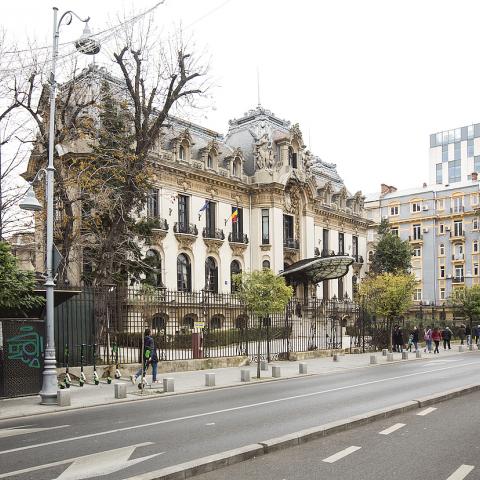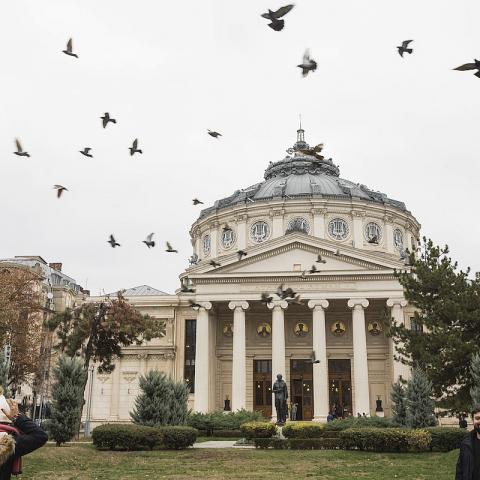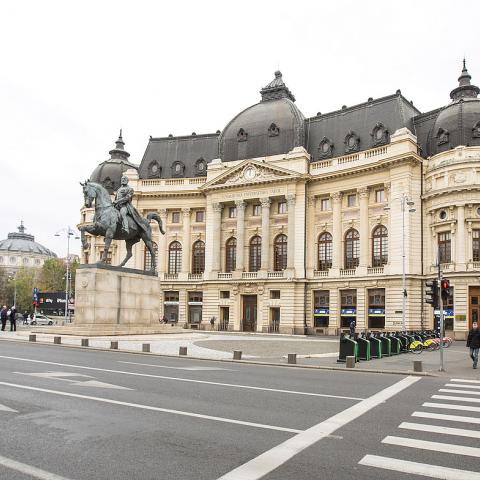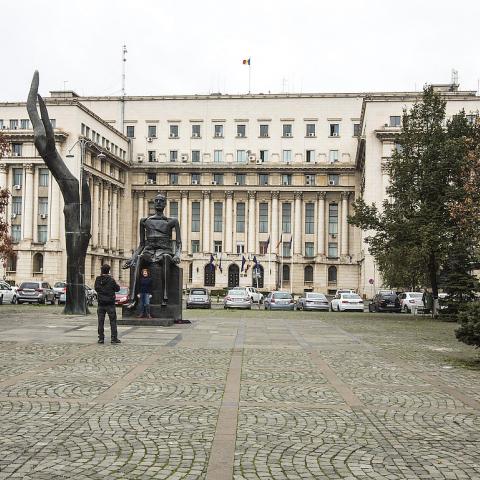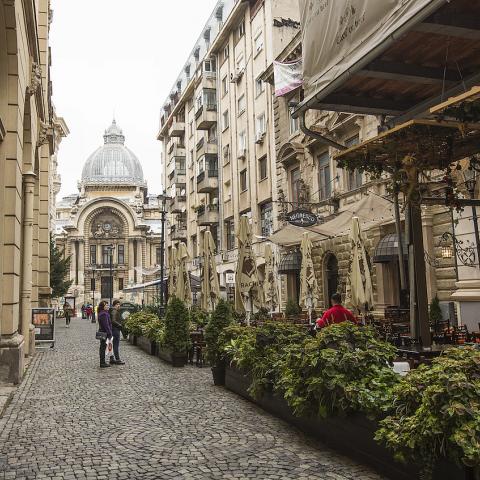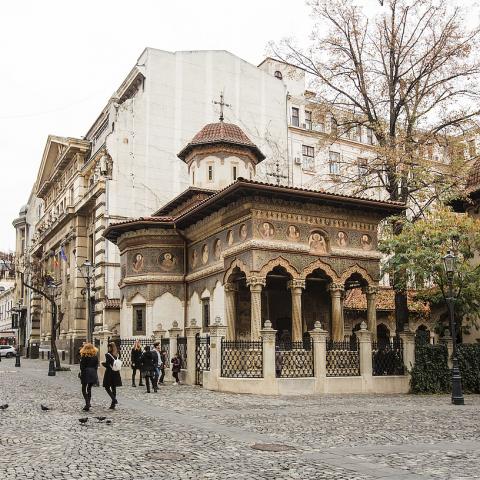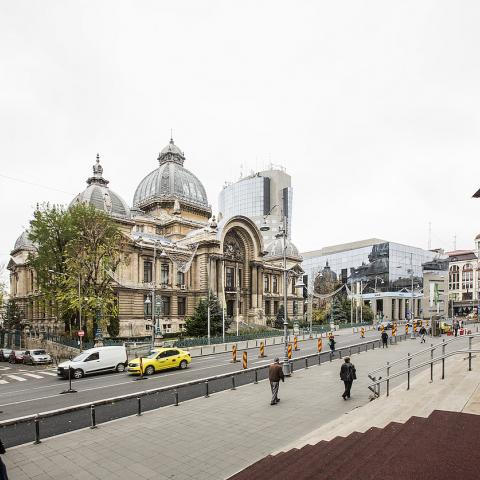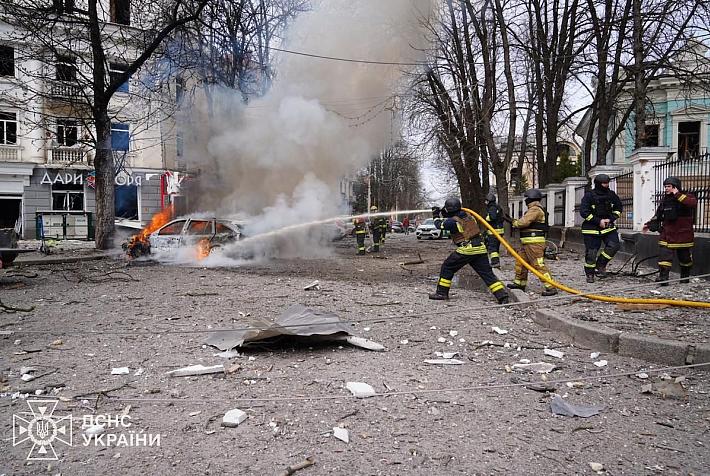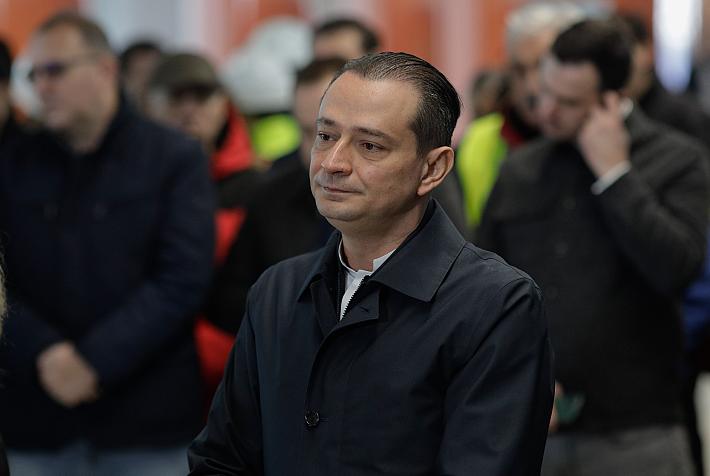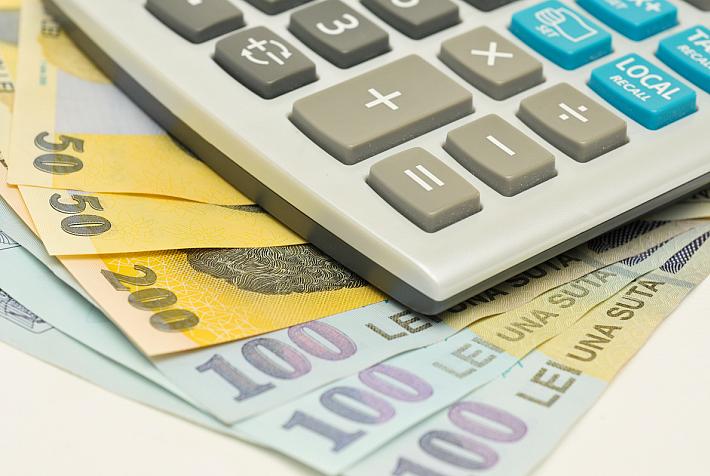"Destination: Bucharest" - A walk on Calea Victoriei
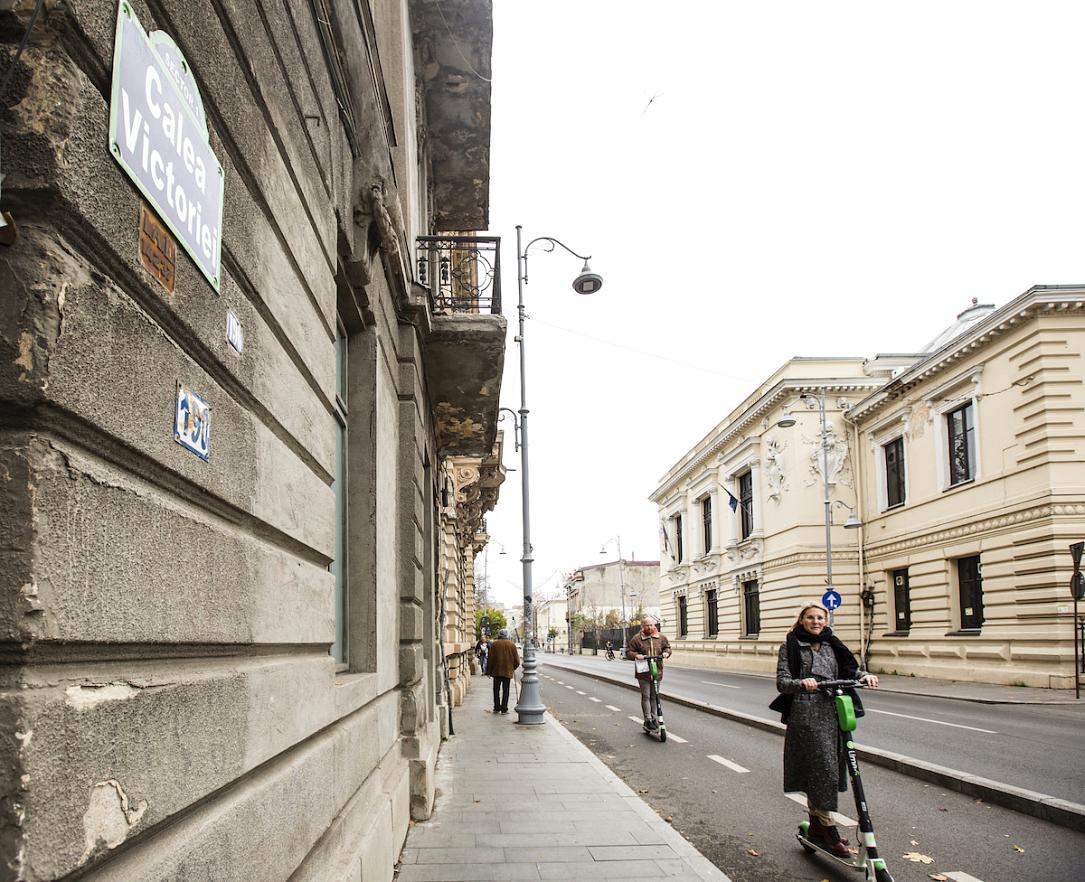
If the streets could tell their stories, Calea Victoriei would definitely have a long history to share. One of the oldest and most beautiful streets of the Capital, Calea Victoriei is the place where the city displays its elegant palaces, invites its inhabitants and visitors to the theater, museums and concerts. We start from Națiunile Unite Square to Victoriei Square to get to know it better.
Today known as Calea Victoriei, the street links its beginnings to the name of Romanian ruler Constantin Brâncoveanu (Alexandru Ofrim - Străzi vechi din Bucureştiul de azi - Old streets from nowadays Bucharest, Humanitas, 2011). In 1692, he built a road to connect his estate on the shore of Dâmboviţa, to the estate of Mogoșoaia, where he would build a palace in 1702. The road was paved with wooden beams, hence its name then, Mogosoaia Bridge. The road was renamed Calea Victoriei only in 1878, after the Independence War, when the victorious Romanian troops made their triumphal entry into the Capital here. Little of the original configuration has been preserved, but almost every building today has a history that connects it to the earlier periods of the road.
It is a cool November morning and the sky is not very clear. From the hotel at the intersection of Calea Victoriei with Ion C. Filitti St. a tourist comes out and approaches to check one of the billboards indicating the attractions in the area. We follow his example and, in a few steps, we are in front of the National History Museum of Romania. It occupies the building of the former Post Palace, opened in 1900. The palace, built on a land on which Brâncoveanu had built an inn called Constantin Vodă, it reminds in its architecture of the post office in Geneva. The elegant façade, with the portico supported by 10 Doric columns, is today a favorite place for photography enthusiasts. Inside, the museum awaits its visitors to discover important pieces of the historical treasure of Romania - among them, the Getic princely treasure from Cucuteni-Băiceni, the princely Getic gold gown from Coţofeneşti, the gold Dacian bracelets discovered at Sarmizegetusa and objects and jewelry of the Royal House of Romania - as well as a replica of Trajan's Column in Rome.
On the opposite side, our attention is drawn by the Palace of the House of Deposits, Consignments and Economy - CEC Palace. Its construction began in 1897, on the site of the monastery and inn of Saint John the Great, settlements restored by Constantin Brâncoveanu in 1702 - 1703. Like many buildings on Calea Victoriei, the palace reflects the admiration of the era for the French culture - it was built according to the plans of the architect Paul Gottereau, with typical elements of French architecture from the end of the 19th century. Its central dome, made of glass and metal, is one of the easily recognizable elements of a symbol building of the Capital and one of the most solid, unaffected by earthquake elements, that have changed the look of the city in other areas.
A little further on, Stavropoleos Street connects with the Old Center of the city. Here we find the Caru' cu Bererestaurant, very popular with tourists and beyond. The restaurant building, with a history of over 130 years, was built in neo-Gothic style, the ground floor being richly decorated with paintings, stained glass, mosaics and carved panels.
On the same street, a few steps away, we find the Stavropoleos Church, an oasis of unexpected silence in a pretty hectic part of the city. Inside you hear the Sunday Mass. In the courtyard, several tourists photograph the architectural details of this monument built in Brancovan style. The church was built in 1724, during the reign of Nicolae Mavrocordat, and testifies to the original site, which also included an inn and several annexes, demolished at the end of the 19th century. When leaving the church yard some children are waiting for their parents, while other tourists photograph the area, one full of interesting details and the perfect spot to take a picture of the CEC Palace.
We return to Calea Victoriei and resume our itinerary, leaving behind the Zlătari Church, rebuilt by Mihai Cantacuzino in 1705, and the Victoria Store, which housed during the interwar period the Lafayette Galeries store, the first large department store in Romania, built after the stores with large exhibition spaces in Paris. We enter to take a look at the Macca-Villacrosse Passage. The two branches of the passage covered with glass start from Calea Victoriei and merge before leaving the Eugeniu Carada Street. The passage, designed by architect Felix Xenopol, bears the name of Xavier Villacrosse, chief architect of the Capital in the years 1840 - 1850, and of his brother -in – law, Mihalache Macca. Customers have not yet occupied the cafeteria terraces in the passage and the colored glass that covers it masks a little of the gloomy morning.
Back on Calea Victoriei we approach the Grand Hotel du Boulevard, one of the oldest in Bucharest, built by Alexandru Orăscu, also the architect of the University of Bucharest building. The hotel opened for the first time in 1873, under the name of Hotel Herdan, and the name of Grand Hotel du Boulevard will be received only in 1877. The elegant building, to be reopened, has hosted receptions, dinners and lavish balls over time, being recognized as a center of Bucharest’s high-life.
We cross the intersection with Regina Elisabeta Boulevard and reach the National Military Circle. Built in 1911 according to the plans of the architect Dimitrie Maimarolu, in the style of the eclectic neoclassicism, the palace is under renovation today. It was built on the site of the former Sărindar Monastery - meanwhile demolished - whose name is kept by the well in front of the palace.
We pass a group of tourists who converse in Spanish and arrive in front of Casa Capșa, the restaurant first opened in 1852, famous for its confectionery and as a meeting place for the local literary elite. A little further on opens the view offered by Odeon Square, the place where we find the Odeon Theater, one of the oldest and most beautiful theaters in the Capital. The architect Grigore Cerchez designed the architectural ensemble the theater is part of, whose Majestic Hall has a sliding ceiling and a l'italienne stage.
We are advancing next to the Telephone Palace building, until the 70s the tallest building in Bucharest, and we are acquainted with the modernist identity of the city. The palace was built between 1929 and 1934, having representative features for the Art Deco style. Beside, the Novotel Hotel reminisces the former location of the Bucharest National Theater, with its entrance that reproduces the facade of the theater building, bombed in August 1944.
We advance next to tourists eager to capture the architecture of the boulevard in a photograph and besides cyclists - Calea Victoriei has a dedicated track along its entire length. We leave behind a few shops selling luxury watches and jewelry, we pass the Muzica Store, another landmark on Calea Victoriei, and we reach the Revolution Square.
Here, awaits us the Crețulescu Church, one of the most valuable architectural monuments from the end of the Brancovan period. It was built in 1720 - 1722 at the initiative of the great boyar Iordache Crețulescu and his wife Safta, one of Constantin Brâncoveanu’s daughters. Near the church there was also an inn, which at that time was located at the northern barrier of the city.
In the square we find the Monument of Corneliu Coposu. Coposu was president of the National Christian Democratic Peasant Party between 1989 and 1995 and former political detainee under the communist regime. The bust was made by sculptor Mihai Buculei. Opposite there is the Monument of Iuliu Maniu - former prime minister of Romania between 1928 and 1933, who died as a political prisoner in the Sighet prison - the work of the sculptor Mircea Corneliu Spătaru. Nearby we find the Memorial of the Renaissance (Memorialul Renașterii), a monumental ensemble built in memory of the 1989 Romanian Revolution victims, made by Alexandru Ghilduș. The area may seem solemn by the accumulation of monuments, but it is also a favorite place for skaters, who often come to practice their skills here.
We continue our journey and reach one of the most important museums in Bucharest - the National Art Museum of Romania. The museum is located in the former Royal Palace. It was first built in 1837 by the ruler Alexandru Ghica, who made it a palace of ceremony out of the house built in 1820 by Dinicu Golescu on the Mogosoaiei Bridge, on the site now occupied by the south wing of the museum. Between 1882 and 1906, Carol I hired for the extension of the palace the architects Paul Gottereau (1882-1885) and Karel Liman, who had also collaborated in the construction of the Peles castle. Other works of reconstruction and amplification of the palace are initiated by Carol II between 1930 and 1937, using the architect Arthur Lorentz. Today, the public can visit here the European Art Gallery, the Gallery of Modern Romanian Art and the Gallery of Old Romanian Art. Also, the palace spaces are open for various cultural events, from concerts to film festivals.
Across the street from the museum we find two other impressive buildings. The first is the Central University Library, located in the Palace of the Carol I University Foundation, the headquarters of the Royal Foundations. The building was designed by the French architect Paul Gottereau and inaugurated in 1895, in the presence of King Carol I. It is the oldest university library in the city and in the past, has housed an important collection of rare books and manuscripts of national cultural personalities, many destroyed by the fire that covered the building during the Revolution of 1989. In front of the library building we find a modern bicycle rental system - the area is also full of cyclists who take turns in front of and around the building of the Romanian Athenaeum.
The Athenaeum was built more than 100 years ago (1886-1888), following the plans of French architect Albert Galleron. For the building of the edifice were also used funds from a public subscription, which remains today in history due to the rhythmic and efficient slogan "Give a leu to the Athenaeum!" (In Romanian: „Dați un leu pentru Ateneu!”). The Athenaeum is the place where the public in Bucharest could meet personalities such as Pietro Mascagni, Richard Strauss, Bela Bartok, Igor Stravinski, Sergei Prokofiev, Maurice Ravel or Herbert von Karajan. The tradition is continued today by the George Enescu Philharmonic or at the George Enescu Festival. The Romanian Athenaeum is not only a symbol of national culture and one of the most beautiful buildings of the Capital, but also a favorite place for photographers, either professionals or amateurs. We find the Athenaeum in the center of a lively agitation, with many passers-by who want a picture with the building in the background.
We cross the Episcopiei Street, take it next to Athenee Palace Hilton, another famous hotel in the capital, also built on the site of a former inn, and soon we reach the White Church, a place of worship - historical monument dating from the beginning of the eighteenth century. On Calea Victoriei follows a section with several shops, cafes or art galleries. Among them we find the café, theater and event space Green Hours Jazz Cafe and the Act Theater. We are preparing to see another museum, but not before admiring the Știrbei Palace, whose caryatids immediately attract our attention. The palace, in neoclassical style, was built according to the plans of the French architect Michel Sanjouand, at the request of Barbu Știrbei, future ruler of Wallachia. At the end of the 19th century, beginning of the 20th century, the palace was famous in Bucharest for the select socialite events organized here. After the nationalization in 1948, the palace housed the Museum of Folk Art until 1977, later becoming the headquarters of the Museum of Ceramics and Glass.
Then we arrive at the Museum of Art Collections, hosted by the Romanit Palace. The palace is one of the oldest in Bucharest, its construction beginning at an early stage in 1812, at that time built for the boyar Constantin Faca, father of the writer Costache Faca. Remaining unfinished, the palace was sold to Grigore Romanit, a supervisor of the House of Bridges, which was in charge of maintaining the main streets of the city. After Romanit's death, in 1834, the building was rented by the ruler Alexandru Dimitrie Ghika and bought by the state two years later, in 1836. At the same time, the restoration of the edifice is ordered, which housed, starting with 1838, the Administrative Court of Wallachia. Now, the art-loving public finds here the Collections Museum, inaugurated in 1978, as a section of the National Art Museum of Romania. Here are displayed works by Theodor Aman, Nicolae Grigorescu, Ioan Andreescu, Nicolae Tonitza, Gheorghe Petraşcu, Theodor Pallady and many others, alongside European and Japanese graphics or religious icons from Transylvania.
A little further on we find the Romanian Academy, which occupies three important buildings in a park rich in vegetation. One of the buildings was the Slătineanu property, another, towards Mihai Moxa street, of the Filipescu family, dating from the first half of the 19th century, while the third body, the library, was built in 1936 - 1937 according to the plans of architect Duiliu Marcu, who also made the building of the Victoria Palace, the Government headquarters, located in Victoriei Square. In the park we see the statue of Minerva, the goddess of wisdom, the work of sculptor Mihail Ecobici, which represents a replica of the institution's logo.
We leave behind the Nicolae Iorga Park, we pass by the Vernescu and Ghica-Grădişteanu houses, and we approach the Cantacuzino Palace, one of the most beautiful in the city. The palace, easily recognizable after the two lions that frame the entrance shaded by the cover in Art Nouveau style, was built according to the plans of the architect Ion D. Berindei. The owner was Gheorghe Grigore Cantacuzino, former prime minister of Romania, nicknamed Nababul for his considerable wealth. After his death, the palace returned to his son Mihai, who left it by will to his wife, Maruca. She married George Enescu in 1939. Today, the Palace hosts the George Enescu National Museum, where various concerts and cultural events take place.
After passing a few other cafes and restaurants we reach the Filipescu-Cesianu house, an example of a boyar house from the beginning of the 19th century. Constantin Cesianu extended his residence in 1892, with the help of the architect Leonida Negrescu, on which occasion the park of the residence was also designed. The building hosts today the Exhibition "Museum of the ages" (in Romanian „Muzeul vârstelor”), organized by the Bucharest Municipality Museum.
For a few minutes we stop in the beautiful park of the house, which also houses an exhibition space. We are at the end of our journey. A little further on, we reach Victoriei Square, leaving behind many histories and monuments from the city’s history and return to the turmoil of the present.
This material is part of a project under the program of promoting the touristic heritage “Destination: Bucharest”, carried out by the Bucharest City Hall through the Public Monuments and Touristic Heritage Administration (AMPT).

Photos by Kathrin Weident/Romania-Insider.com for AMPT






